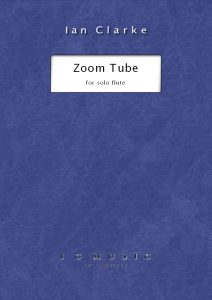Zoom Tube

“Zoom Tube is a simply astonishing piece. …. Ian’s genius lies in his ability to incorporate extended flute techniques for the flute in a way that are thoroughly powerful, natural and accessible musically”
– from programme notes by Wissam Boustany.
Zoom Tube (solo flute – open-holes B foot) is a rhythmic blues influenced piece employing a raft of extended techniques to achieve its aims. A stunning addition to the flute repertoire! It has to be heard to be believed. A challenge to learn but fortunately easier than it looks. Since coming into print in 2001 Zoom Tube has regularly been programmed in professional and final year conservatoire recital performances. It is advisable to play something like ‘The Great Train Race’ and ‘Spiral Lament or some of Robert Dick’s music before Zoom Tube! Having said that there is plenty of explanation so previous experience with extended techniques is not a pre-requisite – just useful!
Zoom Tube has been used several times as an international competition piece including for the NFA’s 2006 Young Artists Competition. It was selected for inclusion in the Peters Edition GCSE Music Anthology in the section ‘Changing Directions of Western Classical Music from 1900’. It has been freely programmed many times by woodwind finalists in the BBC Young Musician of the year including in the winning programme of both the BBCYM, the prestigious 2012 Royal Overseas League competition and many other leading woodwind prizes. It is now listed on the Carnegie Hall/Royal Conservatory (Canadian/USA exam system grade 1- 10 plus ARCT) and AMEB (Australian Music Examinations Board).
New compositions are necessarily, consciously or sub-consciously, influenced by other work. In the case of Zoom Tube there are many inspirations: rhythm & blues, Bobby McFerrin, Stockhausen, Robert Dick, Ian Anderson & South American flute playing spring to mind fairly immediately but I’m sure there’s more if one wanted to delve further. Beyond this I had an impression of what I wanted to achieve and, since I am a composer & flautist, naturally enough its birth was largely through experimentation and improvisation on the instrument. The extended techniques and hence palette of colours was very much a means to an end rather than just an end in itself. Amongst other things I wanted the flute to groove, much as a rhythm guitarist might, so chords (multiphonics) and damping techniques were necessary. When the human voice is used to groove an array of percussive vocalizations are employed to imitate a drum kit or used as interjections to further rhythmic suggestion. Therefore note bending, an array of articulations and the voice were going to feature. I also wanted it to complement the piece called ‘The Great Train Race’ that I had written for solo flute; this had been conceived as a fun and exhilarating work showcasing many extended techniques. I needed a still more diverse and exciting sound world to draw on. As well as the techniques already mentioned the exploration of quartertones and breathy colours fascinated me; singing and speech use subtle pitch inflections that lie outside the well-tempered scale so this seemed an obvious area to explore. In the end I hope I have achieved something new and exciting for the flautist that will surprise and inspire!